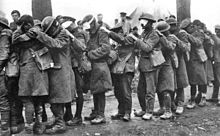Battle of the Lys (1918)
In planning, execution and effects, Georgette was similar to (although smaller than) Operation Michael, earlier in the Spring Offensive.This included two divisions of the Portuguese Expeditionary Corps, which were undermanned, lacked almost half of their officers, had very low morale and were set to be replaced the day of the German attack.[6] The German bombardment opened on the evening of 7 April, against the southern part of the Allied line between Armentières and Festubert.[9] Horne committed his reserves (First King Edward's Horse and the 11th Cyclist Battalion) to stem the German breakthrough but they too were defeated.[13] By 11 April, the British situation was desperate; it was on this day that Haig issued his famous "backs to the wall" order.[14] On 12 April, the Sixth Army renewed its attack in the south, towards the important supply centre of Hazebrouck, another 10 kilometres (6.2 mi) to the west.[15][16] From 13–15 April, the Germans drove forward in the centre, taking Bailleul, 12 kilometres (7.5 mi) west of Armentières, despite increasing British resistance.[17] On 23 March, Haig had ordered Plumer to make contingency plans to shorten the line along the Ypres Salient and release troops for the other armies.[18] During 13 April, General Headquarters (GHQ) discussed the retirements in the Lys valley, which had lengthened the British front line and Plumer agreed to a retirement in the Ypres Salient to the Mt Kemmel, Voormezeele (2.5 mi (4.0 km) south of Ypres), White Château (1 mi (1.6 km) east of Ypres) to Pilckem Ridge defence line but ordered only that artillery ammunition be carried to the rear; the 4th Army reported on 14 April, that the British were still occupying the Passchendaele Salient.The next day was quiet in the salient and the withdrawal of the II Corps and XXII Corps divisions was covered by the outposts in the original front line and artillery, which was divided into some active batteries which fired and a greater number of batteries kept silent, camouflaged and not to fire except in an emergency.

Battle of the Lys (1940)Western FrontFirst World WarFlandersBelgiumFranceUnited KingdomAustraliaCanadaNewfoundlandNew ZealandSouth AfricaPortugalUnited StatesGermanyDouglas HaigHerbert PlumerHenry HornePhilippe PétainTamagnini de AbreuGomes da CostaKing Albert ICyriaque GillainArthur CurrieLudwig von FalkenhausenFerdinand von QuastFriedrich Sixt von ArminRed BaronMoresnetInvasion of BelgiumLiègeDinantFrontiersLorraineArdennesCharleroiTrouée de CharmesGreat RetreatLe CateauÉtreux1st St. QuentinMaubeugeGrand Couronné1st Marne1st AisneAntwerpRace to the Sea1st YpresWinter actions1st Artois1st ChampagneHartmannswillerkopfNeuve Chapelle2nd Ypres2nd ArtoisHébuterne2nd Champagne3rd ArtoisGas: WieltjeThe BluffHohenzollern RedoubtSt EloiHulluchWulverghemKink SalientVimy Ridge 1916Mont SorrelVerdunBoar's Head1st SommeFromellesAlberichNivelle offensive2nd AisneThe HillsMessinesPasschendaeleLa MalmaisonCambraiGerman spring offensiveMichael3rd AisneBelleau Wood2nd MarneSoissonsAmiensAilette2nd SommeSaint-MihielSt Quentin CanalMeuse-Argonne5th Ypres2nd CambraiCourtraiSambreLys and Escaut1914 Christmas truceFrench Army mutiniesWestern Front tactics, 1917Seicheprey 3rd Aisne3rd MorlancourtOrder of BattleErich LudendorffChannel portsOperation MichaelBéthuneArmentièresBelgian ArmyBritish Second ArmyPlumerBritish First ArmySixth ArmyFourth Armystosstruppenstormtroop tacticsPortuguese Expeditionary CorpsEnglish ChannelCalaisDunkirkBoulogneFestubertSecond Division55th (West Lancashire) Division40th DivisionKing Edward's Horse